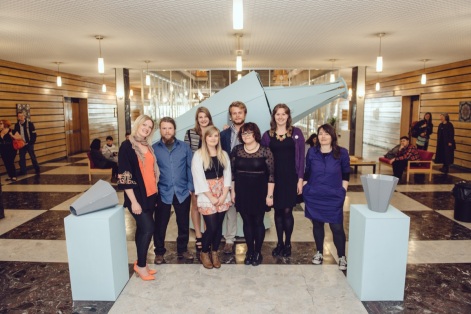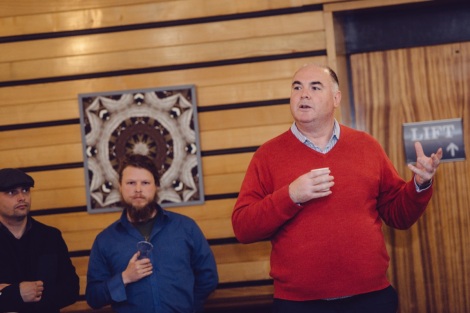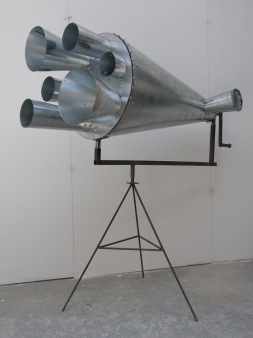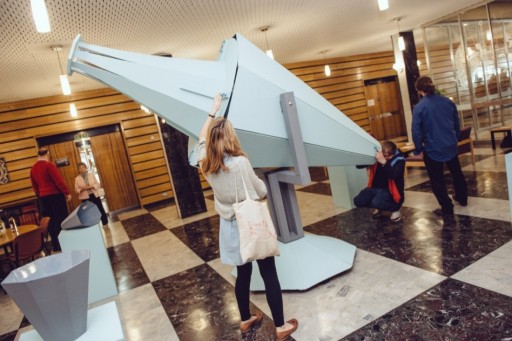
‘The Future of Plymouth’ exhibition. Photography by Dom Moore (2014)
The main feature of the artwork Eight (2014) consists of a kaleidoscopic viewfinder in the form of a kinetic, interactive sculpture. The sculpture is positioned in the centre of the foyer space in the Plymouth City Council House building and is accompanied by four smaller octagonal viewfinders on plinths. The viewfinder reflects on ideas of looking forward into the future of Plymouth’s art and culture with the kaleidoscopic affect abstracting the already present historical features of the 1950’s Council House building. The large, kinetic sculpture is also something new and challenging to the Council House space, offering visitors of the space the opportunity to interact with the viewfinder. We also felt as a group that through the use of an interactive artwork, we would bring control back into a space that would sometimes feel overwhelming for particular visitors.
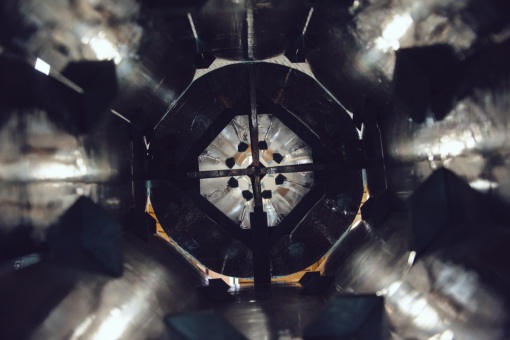
‘The Future of Plymouth’ inside the sculpture. Photography by Dom Moore (2014)
How the sculpture operates
The video above shows a GIF video made by Lee McDonald of the kaleidoscopic viewfinder in motion in the Council House foyer as well as how the sculpture looks from the viewers perspective when looking through the viewfinder. The kaleidoscopic viewfinder is around 3 meters in length and 2 meters high and rotates 360 degrees on a pivot whilst the base secures the sculpture. In order to interact with the sculpture, the participant must look through the smaller hole of the viewfinder and using the handles, rotate the sculpture around the foyer space. It is recommended that ideally two people operate the sculpture at once in order for one person to look through the viewfinder and move the body of the sculpture up and down or around the space whilst the other person rotates the end attachment using the handles provided. The reflective material inside of the sculpture abstracts the viewer’s vision of the Council House space by reflecting the light of the room in different angles and creating an almost kaleidoscopic effect.
(For more videos of the sculpture please use this link)
Constructing the sculpture
This slideshow requires JavaScript.
The slideshow above shows the process in designing the kaleidoscopic viewfinder through design plans, maquettes and 3D floor plans. In order to have a good idea of the materials needed to make the sculpture and whether our ideas for the sculpture were possible, Lee McDonald and William Danby drew out some initial sketches of how the sculpture would operate and look. From this we also considered what size we wanted the sculpture to be. Our initial design plan consisted of only the one eight-sided cone for the sculpture with several different sized cones at the end which would rotate. After we had the initial designs, William created a small maquette of the viewfinder body on a small metal frame using a pencil to make the body pivot up and down so that the group could envision how the sculpture would operate. Using the maquette, William also drew out a floor plan of the Council House space in the studio in order for everyone in the group to consider the size of the sculpture and where we would want the viewfinder in relation to the rest of the objects in the space. After we had considered the needed materials and sizes for the sculpture, William then went on to draw out some more detailed designs of the body of the viewfinder and its base as it was important the the materials used for these parts were very sturdy when being rotated. It was also important to consider how the large sculpture would rotate both on the stand as well as the end section of the sculpture. Our initial plans for the rotation of the sculpture included the use of a a powered motor which would make the sculpture partly electrical, however we concluded that it would be better to make the sculpture using a ‘Lazy Susan’ bearing which would be operated by hand as to avoid any fire risks or other problems in the space.
This slideshow requires JavaScript.
The slideshow above shows the construction of the Kaleidoscopic viewfinder from beginning to end. As we were given no budget towards the project, sourcing free materials to make the sculpture with was our main priority as a group. Lee McDonald and William Danby guided the making of the sculpture due to their knowledge and skills of working with woodwork and sculptures with the rest of the group lending a hand as much as possible. Within the studio, we had managed to source large wooden boards which were no longer in use, as well as reflective material, blue and grey paint and other tools. This gave us a great head start to beginning the construction of the sculpture and saved us a lot of money. However, as we progressed further into the construction of the sculpture so did our ideas for the design and in order to make this possible as well as sturdy and safe, we required stronger wood and much more materials pushing us to spend around £200 on the sculpture alone.
Constructing the sculpture was a long and hard task and required a lot of hands to get the task done. We began by cutting down the wooden boards to create triangles which would be fitted together to make the eight-sided cone shape. Our initial intentions of having multiple different sized cones at the end of the sculpture changed whilst constructing the sculpture due to realisation of how it would not be possible to focus properly when looking through the sculpture. Because of this we chose to go with only one larger eight-sided cone which would be reversed and attached to the end of the body of the sculpture. When assembling the sculpture we had to ensure that everything was stable and strong and could withstand the weight of the sculpture being moved around. To ensure the sculpture would be safe when operated, we chose to use a ‘Lazy Susan’ bearing which joined the base and the stand of the sculpture. This meant that the sculpture would rotate from the bottom of the stand rather than the top of the stand which would ensure safer movement. In order to test the stability of the stand and the functionality of the ‘Lazy Susan’, William used his own weight by standing on the stand and rotating the base. The end of the sculpture also rotated through the use of a large bearing and wood positioned in a cross attached to the body. Once all parts of the viewfinder were constructed they were sanded down and cleaned up with wood filler to make sure that all holes, gaps and screws were covered.
From here we chose to purchase a shiny adhesive material which we cut down to size and secured to the inside of the cones making to sure to cover as much of the insides as possible. We then painted the sculpture using a sky blue colour to paint the cones and base, and a grey colour for the stand. When deciding on a colour for the viewfinder, we decided on this sky blue colour due to its relation to Plymouth being known as an ocean city and the colour being a bright and positive colour which we felt would stand out in the space. Luckily enough this particular coloured paint was one of the pots we had found in our studio. We chose a grey colour to paint the stand with as we felt it complimented the blue well and added to the futuristic feel we were aiming for. Finishing off the last touches, we added four blue door handles to both the front and the end of the sculpture so that it would be easier for the participant to rotate either end of the viewfinder. We also secured canvas material to the top of the base to cover any imperfections and painted it blue as well as covering the bottom with carpet to refrain from an damage coming to the Council House floor.
Evaluation
Looking back at the sculpture, we discussed as a group that if we had had more money and time to construct it properly we would have chosen to use mirror rather than the reflective adhesive material which we used as we felt this would have given us a more affective kaleidoscopic result. We also concluded that having a larger ‘Lazy Susan’ bearing for the end section of the viewfinder would have been preferred as the turning would be more smoother as well as there being no wooden cross on the inside obstructing the viewers vision. From a personal perspective, I also feel that the use of coloured or patterned filters would have added a nice effect to the outcome of looking through the viewfinder. However overall myself and the group were very happy with the outcome of the sculpture and felt that it was strong, safe and performed well.
References:
Moore, D. (2014). The Future of Plymouth exhibition. [image] Available at:http://www.plymouthart.ac.uk/latest/blog/fine-artists-present-kaleidoscopic-body-of-work-at-council-house/ [Accessed 27 May. 2014].
Moore, D. (2014). The Future of Plymouth inside the sculpture. [image] Available at:http://www.plymouthart.ac.uk/latest/blog/fine-artists-present-kaleidoscopic-body-of-work-at-council-house/ [Accessed 27 May. 2014].
McDonald, L. (2014). The Future of Plymouth project. Available at: http://vimeo.com/96620245[Accessed 27 May. 2014].
